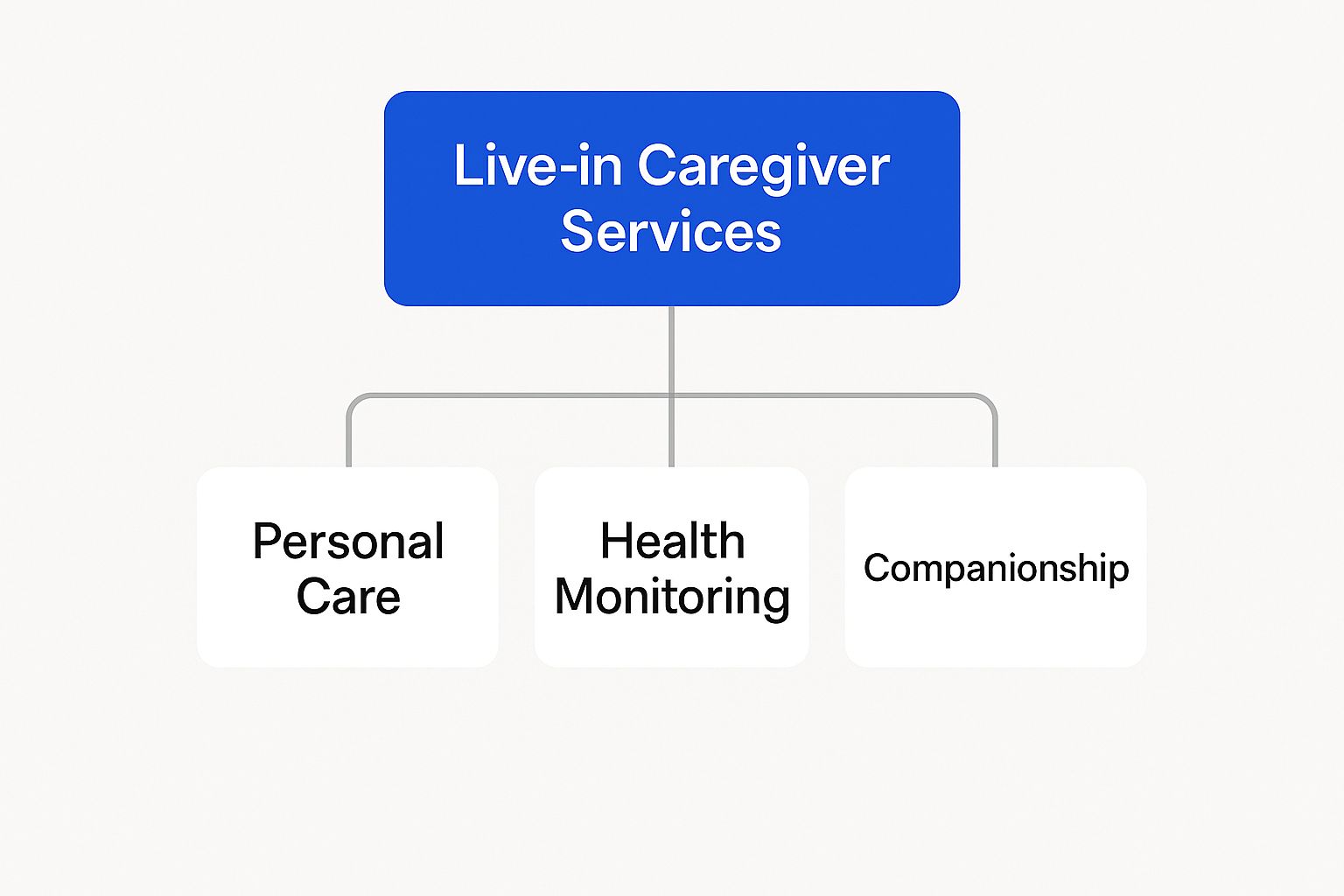When you hear the term live-in caregiver services, it describes a special kind of dedicated, around-the-clock support. It’s for people who need consistent help but want to stay right where they feel most comfortable—their own home. In this model, a professional caregiver actually lives in the home, offering continuous care, companionship, and household help that’s built around the senior’s own life and rhythms. It’s all about promoting safety and independence in a familiar, comforting space.
What This Care Model Truly Involves
Picture a dedicated care partner whose main job is to ensure your loved one's comfort and well-being, day and night. That’s the heart of live-in caregiver services. Unlike other care models that are based on scheduled visits, this approach embeds a caregiver right into the home, fostering a uniquely consistent and personal support system.
But it’s about more than just having someone there. It’s about building a genuine, trusting relationship. The caregiver becomes deeply familiar with the subtle shifts in a senior’s health, mood, or daily patterns, which allows them to proactively adjust care as needed. This constant, caring presence goes a long way in reducing common risks like falls, medication mix-ups, and the profound loneliness many seniors face when living alone.
The Scope of Support
The support from a live-in caregiver is incredibly broad and flexible. It’s designed to be a holistic approach to well-being, generally covering three core areas of assistance.
- Personal Care: This is the hands-on help with Activities of Daily Living (ADLs), like bathing, dressing, grooming, and moving around safely.
- Household Management: The caregiver also pitches in with light housekeeping, preparing nutritious meals, doing laundry, and handling grocery runs to keep the home environment safe and pleasant.
- Companionship and Engagement: Maybe the most important part—a live-in caregiver offers vital emotional support, participates in hobbies, and provides daily conversation, all of which are crucial for strong mental and emotional health.
This visual gives you a great sense of how these essential support categories all stem from the core service.

As the diagram shows, live-in caregiver services aren't just one thing. It's a comprehensive solution that weaves together personal, health, and social support into one seamless experience.
To help you see where this model fits, this table quickly outlines the fundamental differences between live-in care and other common senior care options.
Comparing Live-In Care with Other Senior Care Options
| Care Type | Primary Setting | Level of Attention | Ideal For |
|---|---|---|---|
| Live-In Care | Senior's Own Home | One-on-one, consistent | Seniors needing steady support but not constant awake supervision. |
| 24-Hour Shift Care | Senior's Own Home | One-on-one, awake staff | Seniors with intensive medical needs or high fall risk requiring alert staff 24/7. |
| Assisted Living | Residential Community | Shared staff, group setting | Seniors who are mostly independent but need help with some daily tasks and enjoy social activities. |
| Hourly Home Care | Senior's Own Home | One-on-one, scheduled visits | Seniors needing help for a few hours a day with specific tasks like meals or bathing. |
Each model serves a different need, and understanding these distinctions is key to making the right choice for your family's situation.
Distinguishing Live-In From 24-Hour Care
It’s really important to know the difference between the live-in model and 24-hour shift-based care. Both provide continuous coverage, but they are structured very differently.
In a live-in arrangement, one primary caregiver resides in the home and is provided with private sleeping quarters and mandated rest periods. This consistency helps build a strong bond. In contrast, 24-hour care typically involves two or three caregivers working in 8 or 12-hour shifts to provide constant, awake supervision.
The live-in model works especially well for individuals who need reliable support throughout the day and night but don't require the kind of intensive medical monitoring that demands a caregiver be awake and alert at all hours. As you explore your options, understanding these subtle differences will help you choose the right level of assistance. For a visual cue on how these service identities are built, you can check out this example of a caregiver service logo. Getting clear on the details ensures your loved one receives the best possible care while maintaining their quality of life at home.
The True Benefits of Consistent In-Home Care

The advantages of live-in care go far beyond simple convenience. When you choose this path, you're embracing the powerful benefits of aging in place—a decision that research consistently links to greater happiness, better health, and a richer quality of life for seniors. It just makes sense that older adults feel a stronger sense of life satisfaction when they can remain in their own familiar, comfortable surroundings.
This model of care brings the immense value of one-on-one, continuous support from a single, dedicated caregiver. It’s a level of personal attention that’s simply not possible in a facility, where staff have to split their time and focus among many different residents.
Fostering Security and Building Bonds
One of the biggest pluses is the deep sense of security that develops over time. Just knowing that a trusted caregiver is always there, day and night, is incredibly reassuring for both the senior and their family. This constant presence also acts as a powerful safeguard against common household accidents.
And if an emergency does happen, like a fall or a sudden health problem, the response is immediate. There’s no waiting for a scheduled visit or for someone to answer a call button; help is right there in the home. This quick action can make a world of difference, preventing a minor issue from turning into a major crisis.
But it’s not just about physical safety. The consistency of live in caregiver services allows a genuine human connection to form. What starts as a professional relationship often blossoms into a real friendship built on shared daily life and mutual trust.
This consistent companionship is a direct and powerful antidote to loneliness and social isolation, which studies have linked to a decline in both mental and physical health. A live-in caregiver provides not just assistance but also conversation, shared activities, and emotional support.
This bond becomes a cornerstone of the service, turning daily routines into a more engaging and joyful experience. The caregiver becomes a familiar face, a confidant, and a source of positivity, which can dramatically improve a senior’s mood and outlook on life.
Unmatched Peace of Mind for Families
For families, the peace of mind that comes with live-in care is priceless. The constant worry about a loved one's safety, nutrition, or loneliness fades away, replaced by the confidence that they are in capable and compassionate hands. It puts an end to the frantic phone calls and stressful, last-minute trips to handle unexpected problems.
Instead of managing daily crises, families can focus on what really matters: spending quality time together. Visits become about connection and making memories, not running through a checklist of caregiving tasks. This dynamic allows adult children to simply be sons and daughters again, not care managers.
Here are some of the core advantages for family members:
- Reduced Stress: A professional caregiver handles the daily management of care, scheduling, and emergencies.
- Improved Relationships: Families can enjoy more positive and meaningful time with their aging parents.
- Constant Communication: Good agencies provide regular updates, keeping you in the loop about your loved one's well-being.
- Freedom and Flexibility: Family caregivers get back the time and energy to focus on their own lives, careers, and families.
A Financially Sound Decision
While cost is always a major factor, live-in care can often be a smarter financial choice than institutional alternatives. This is particularly true for anyone who needs constant supervision or would otherwise require 24-hour care from multiple caregivers working in shifts, which can be significantly more expensive. For a helpful resource on how service identities are built, you can explore this example of a caregiver service logo design.
In a nursing home or assisted living facility, the fees cover not just care but also major overhead costs for the building, administration, and shared amenities you may not even use. With live-in care, your money goes directly toward the dedicated, one-on-one support your loved one receives. When you look at the all-inclusive nature of live-in support versus the layered costs of a facility, the value really becomes clear.
How to Budget for Live In Caregiver Services

Figuring out the financial side of live in caregiver services is a crucial part of planning for long-term support. While it's often a more affordable and personal alternative to a nursing home, it’s still a major investment. Taking the time to build a clear budget now will help you prepare and prevent any financial surprises down the line.
The first thing to get your head around is how these services are usually billed. Unlike hourly home care, live-in care is typically structured with a flat daily or weekly rate. This actually simplifies budgeting, giving you a predictable, all-inclusive cost for the caregiver's dedicated time and presence in the home.
It's really important, though, to ask exactly what this rate covers. The fee almost always pays for the caregiver’s wages—both for their active work and their on-call availability. What it doesn't usually include is the cost of room and board (a private room and meals), which you provide as part of having them live in the home.
Key Factors That Influence Cost
The final price for live in caregiver services isn't a one-size-fits-all number. Several key factors can shift the rate you'll pay, and understanding them ahead of time will give you a much more accurate picture of the costs.
- Level of Care Required: This is the biggest variable. A loved one who mostly needs companionship and help with daily chores will naturally have a lower rate than someone who needs significant personal care, help with mobility, or specialized support for dementia.
- Geographic Location: Where you live matters. Costs in major metropolitan areas, including many parts of New Jersey, are higher because the cost of living is higher. This translates to higher caregiver wages compared to more rural areas.
- Agency vs. Private Hire: Going through a reputable agency might seem more expensive at first glance, but it comes with critical protections. Agencies handle all the complex stuff: payroll, taxes, insurance, and liability. They also provide caregivers who are already vetted, trained, and have backup staff available. When you hire privately, you become the employer, making you responsible for all of those legal and financial details yourself.
Think of an agency as a general contractor for your care needs. They manage all the complex logistics—vetting, scheduling, insurance, and compliance—so you can focus on your loved one’s well-being. This built-in support system is a key part of the value.
Unpacking the Financials: What Is and Isn't Included
When you get a quote from an agency, ask for a detailed breakdown of every associated cost. A transparent agency will be completely upfront about what their main fee covers and what other expenses you should plan for.
Here’s a common breakdown to help you see the difference:
| Usually Included in the Daily Rate | Usually a Separate Family Expense |
|---|---|
| Caregiver's wages and salary | Groceries and food for the household (including the caregiver) |
| Agency administrative fees | A private, furnished room for the caregiver |
| Liability and workers' compensation insurance | Household utilities (water, electricity, internet) |
| Backup caregiver arrangements | Transportation costs if using the family car for errands |
Getting clear on these details from the very beginning prevents misunderstandings and helps you build a realistic, comprehensive budget for your live in caregiver services.
Exploring Ways to Fund Live In Care
The thought of funding live-in care can feel overwhelming, but there are several paths that can help families manage the expense. While Medicare generally doesn't cover long-term custodial care, other options are often available.
Long-Term Care Insurance: If your loved one has a long-term care insurance policy, this is usually the best place to start. These policies are specifically designed to pay for services like in-home care. You'll want to review the policy's "elimination period" (the waiting period before benefits kick in) and the daily benefit amount to know exactly what it will cover.
Veterans' Benefits: Veterans and their surviving spouses may qualify for benefits like the Aid and Attendance pension. This program provides monthly payments to qualified veterans who need help with daily activities, and the funds can be used to pay for a live-in caregiver.
Private Pay: Many families fund care through a mix of savings, pensions, and other private assets. This approach offers the most flexibility but requires careful financial planning to make sure the funds last. Talking with a financial advisor can be a huge help in structuring a plan that works for the long haul.
Of course. Here is the rewritten section, crafted to sound completely human-written and match the expert, natural style of the provided examples.
Is Live-In Care the Right Choice for Your Family?
Choosing the right kind of care is a huge decision, one that feels different for every family. There's no one-size-fits-all answer. The real goal is to find a solution that fits your loved one’s unique needs, their personality, and their home life. While live in caregiver services aren't for everyone, they can be a game-changer in the right situations, dramatically improving a person's quality of life.
Think of it this way: this model is perfect for seniors who need someone consistently there for support and safety, but don't need the kind of intensive medical care a registered nurse provides. It's more about having a reassuring presence and a helping hand than it is about constant, complex medical procedures.
When Live-In Care Truly Shines
Some situations almost seem tailor-made for the benefits of having a caregiver living in the home. If any of these sound familiar, live-in care might be the perfect fit you've been looking for.
- For Seniors with Cognitive Decline: People living with Alzheimer’s or other forms of dementia find immense comfort in routine and familiar surroundings. Having one consistent, trusted caregiver in their own home can significantly reduce the confusion and anxiety that often come with these conditions, creating a much calmer and more stable environment.
- For Individuals with a High Fall Risk: The danger of a fall doesn't stick to a 9-to-5 schedule. For anyone who's a bit unsteady on their feet, having a caregiver present around the clock means immediate help with getting around and a fast response if an accident happens. That peace of mind is priceless.
- During Post-Surgical Recovery: Getting back on your feet after a major surgery, like a hip replacement or heart procedure, takes time and a lot of support. A live-in caregiver can take the pressure off by handling household chores, helping with personal care, and making sure the recovery journey is as smooth and safe as it can be.
Sometimes a real story says it best. Take Eleanor, an 88-year-old who grew fearful and withdrawn after a bad fall made her afraid to be alone. Her family brought in a live-in caregiver, Maria. Not only did Maria help with meals and getting around, but she also discovered their shared love for gardening and got Eleanor back out in the yard. Within months, Eleanor had her confidence and her spark back—all because she had that consistent, compassionate support right where she was most comfortable.
Knowing When It Might Not Be the Best Fit
Let’s be honest—it’s crucial to look at the whole picture. Live-in care is a fantastic option, but it has its limits. Recognizing what it isn't designed for is just as important as knowing its strengths.
The biggest distinction comes down to the need for skilled nursing care. Live-in caregivers are experts in personal care and companionship, but they aren't medical professionals. If your loved one needs help with things like wound care, injections, managing a ventilator, or other tasks that legally require a licensed nurse, you’ll need a different kind of support, like 24-hour shift-based nursing.
The best approach is to be clear with any potential agency about the specific level of medical care required. By carefully matching your loved one’s daily needs with what live in caregiver services can provide, you can make a decision that you feel truly confident in.
Navigating the Current Caregiver Shortage

If finding a qualified, compassionate caregiver feels like an impossible task right now, you aren't imagining things. Families just like yours are running into a serious supply-and-demand problem when it comes to professional care. It’s not just a local issue—it’s a nationwide caregiver shortage, and it's being driven by some powerful demographic shifts.
The simple truth is our population is aging. More seniors than ever are choosing to live independently at home, but the pool of professional caregivers just isn't keeping up. Understanding this reality is the first step toward setting realistic expectations for your search for live in caregiver services.
But this isn't meant to discourage you. Far from it. Instead, it shines a spotlight on just how valuable partnering with a reputable home care agency can be. They're on the front lines of this challenge every single day, and the best ones have mastered the art of finding top-tier talent in a competitive landscape.
The Forces Driving the Caregiver Shortage
At its core, the problem is straightforward: the number of older adults who need care is growing much faster than the number of people entering the caregiving profession. This isn't just a trend in the United States; it's happening all over the world.
This demographic shift is massive. With people living longer and birth rates declining, the percentage of the population aged 65 and older is skyrocketing. This has huge implications for elder care. A global analysis actually predicts that to maintain the current ratio of caregivers to seniors, advanced economies will need a 60% increase in their elder care workforce by 2040. That translates to a need for about 13.5 million more care workers.
Here in the U.S., we're facing our own projected shortfall of over 150,000 caregivers by 2030, which will only intensify the strain on families and the care system. You can read more about the research on this global caregiver shortage and its causes.
This growing gap creates an incredibly competitive environment where experienced, reliable caregivers are a hot commodity. For a family trying to hire someone privately, it can feel like searching for a needle in a haystack.
The caregiver shortage isn’t just a statistic; it’s a real-world challenge that impacts a family’s ability to find timely, high-quality care. It underscores the critical need for effective recruitment, rigorous vetting, and professional support systems.
How Reputable Agencies Provide a Solution
This is exactly where a professional home care agency becomes your most valuable partner. While you see the shortage as a roadblock, they see it as their daily operating environment. The most successful agencies have built sophisticated strategies to overcome these exact challenges and build a strong, dedicated team of caregivers.
They don’t just sit back and wait for applicants to show up. They are actively recruiting, building relationships in the community, and creating a workplace that attracts and, more importantly, retains the best talent. This proactive approach gives them a massive head start in a tight labor market.
Working with an established agency provides several key benefits that directly combat the effects of the caregiver shortage:
- A Deeper Talent Pool: Agencies are always recruiting. They have access to a much wider network of qualified candidates than any single family could ever hope to find on their own.
- Rigorous Screening and Vetting: They handle the crucial—and time-consuming—process of background checks, reference verification, and skills assessments. This ensures every caregiver is not only competent but completely trustworthy.
- Guaranteed Backup and Relief Care: One of the biggest headaches of the shortage is inconsistency. A good agency has a team of relief caregivers ready to step in for sick days or emergencies, so there are never gaps in your loved one's care.
- Professional Training and Development: The best agencies invest in their people. They provide ongoing training in specialized areas like dementia care, safety protocols, and communication skills, which elevates the quality of care your loved one receives.
By leaning on an agency's expertise, you aren’t just hiring an individual. You're plugging into a complete support system designed to deliver reliable, high-quality live in caregiver services, even when the market is tough. They do the heavy lifting so you can have peace of mind.
A Step-by-Step Guide to Choosing a Caregiver Agency
Choosing a provider for live in caregiver services is without a doubt the most important decision you'll make. You're not just hiring someone to help out; you're inviting a trusted partner into your home to care for a family member. It can feel overwhelming, but a clear, step-by-step approach helps you look past the slick marketing and find an agency that genuinely delivers on its promises of quality, safety, and compassion.
Think of it like hiring for the most critical job in the world—because, for your family, it is. The right agency becomes your support system, handling all the complex logistics so you can simply focus on your loved one. The wrong one, however, can introduce a new layer of stress and uncertainty right when you need it least.
The Non-Negotiable Agency Checklist
Before you pick up the phone, it’s wise to have your deal-breakers figured out. Any agency that can't tick these essential boxes shouldn't make your shortlist. These are the absolute foundations of a safe, professional, and trustworthy operation.
- Proper Licensing and Insurance: The agency must be licensed by the state of New Jersey. They also need to carry full liability insurance and workers' compensation. This is what protects your family from any potential legal or financial headaches down the road.
- Rigorous Caregiver Screening: Ask them to walk you through their screening process. It needs to include national criminal background checks, verification of all certifications, and in-depth reference checks. No exceptions.
- Comprehensive Training Programs: A great agency invests in its team. Find out about their initial training and, just as importantly, their ongoing education requirements. This is especially critical for specialized needs like dementia care or helping with mobility.
A truly reputable agency doesn't just see these criteria as a checklist. They see it as the bedrock of their entire commitment to keeping clients safe and providing high-quality care. Never hesitate to ask for proof of their license and insurance—a professional agency will have it ready and be happy to share.
Critical Questions to Ask Every Agency
Once you've narrowed down your list to a few agencies that meet the basic requirements, it's time to dig in. Your goal here is to get a real feel for how they operate day-to-day and handle the curveballs that life inevitably throws. Their answers will tell you everything you need to know about their character and competence.
- How do you handle caregiver absences or emergencies? A professional agency will have a solid backup plan. They should be able to provide a qualified relief caregiver immediately, ensuring there are never any gaps in care.
- What is your process for creating and updating a care plan? A person's needs are rarely static. The agency needs a clear system for the initial assessment and regular re-evaluations, which should always involve the family, the client, and a supervising nurse.
- How do you determine the right caregiver-client match? This is huge. Personality and temperament are just as important as a caregiver's skills. Ask them how they match personalities to encourage a positive, warm, and lasting relationship. A successful placement in live in caregiver services hinges on getting this right.
- Can we interview potential caregivers before making a final decision? This is a completely reasonable request. Being able to meet and chat with a potential caregiver is key to making sure everyone, especially your loved one, feels comfortable.
By asking these direct questions, you give yourself the power to make a truly informed choice. To get a sense of how a professional service presents itself, you can review this sample caregiver service logo and see how branding can reflect a sense of commitment. A little diligence now ensures you find a partner who is genuinely dedicated to creating a safe, supportive, and caring environment.
Frequently Asked Questions About Live-In Care
When you're getting close to a decision on live-in caregiver services, the big-picture questions often give way to the practical, day-to-day ones. It’s totally normal. Getting clear answers to these specifics is what helps you move forward with confidence.
Let's walk through some of the most common questions families ask us. Thinking through these scenarios now is the key to making sure everything runs smoothly for you, your loved one, and the caregiver.
What Happens When the Caregiver Needs Time Off?
This is usually one of the first things people ask, and for good reason. It also highlights one of the biggest advantages of working with a professional agency. Any quality agency has a solid plan for caregiver time off, whether it’s a planned vacation or an unexpected sick day.
They will have a relief caregiver—who is also fully screened, trained, and qualified—ready to step in and cover the shift. This ensures there's never a gap in care or supervision. If you were to hire someone privately, you'd be the one scrambling to find a replacement, which is a stressful situation no one wants to be in.
How Do You Handle Privacy for Everyone?
For any live-in arrangement to work long-term, mutual respect for privacy is non-negotiable. Think of clear boundaries as the foundation for a healthy, positive relationship between your loved one and their caregiver.
The professional standard is simple: the caregiver must have their own private, furnished room. This isn't just a place to sleep; it's their personal space to rest, recharge, and have downtime. A good care agreement will clearly lay out these expectations for personal time and space for everyone, ensuring both the client and caregiver feel comfortable and respected in the home.
What If Their Personalities Don't Click?
This is a huge factor. A great personality fit can make all the difference, turning care into true companionship. On the flip side, a poor match can create tension and stress for everyone.
Professional agencies get this. They have a process for when the chemistry just isn’t there. If you feel the match isn't working out, the agency will talk with you to pinpoint the issues and then find a new caregiver whose personality and approach are a better fit for your loved one. Their ultimate goal is to find that perfect match.
Can Live-In Caregivers Provide Medical Care?
It’s crucial to understand the distinction here. The answer really boils down to the caregiver's individual certifications and training. Most live-in caregivers are experts in non-medical personal care. This includes things like:
- Help with bathing, dressing, and getting around
- Preparing meals and doing light housekeeping
- Providing companionship and engaging in activities
- Giving medication reminders
What they typically can't do are skilled medical tasks—think giving injections, changing wound dressings, or managing complex medical devices. If your loved one needs that level of skilled nursing care, the agency can coordinate with a licensed nurse to provide those services, either alongside the personal caregiver or as part of a more comprehensive plan.
At NJ Caregiving, we know these questions are just the start. Our team is here to listen and give you the straightforward answers you need to make the right choice for your family. To learn more about our compassionate and professional live-in caregiver services, visit us online.



